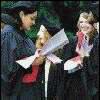 |
|
Ontario Election 1999 Background Papers
BACKGROUNDER #2: Changes to the Election Rules
I. Decreased number of constituencies from 130 to 103
The Harris Government made radical changes to the election rules during their term in office. First, they decreased the number of constituencies from 130 to 103 using the same boundaries as Ontario's Federal ridings. That change increased the average number of voters per constituency from 51,290 to approximately 69,085, based on the 1997 Federal voters list.
II. Increased by 42 per cent the amount of money a candidate's campaign can spend
Harris increased -- by 42 per cent -- the amount of money a candidate's campaign could spend from an average of $46,734 to approximately $66,322. In the 1995 election, most candidates did not come close to spending the limit. On average, Tory candidates spent 77 per cent of the expenditure limit; Liberal candidates spent 79 per cent; and NDP candidates trailed badly, spending on average only 50 per cent of what they were allowed to spend.
The Tories have raised more money since 1995 than any other party in Ontario electoral history. The savings accounts of most Tory ridings are bulging, and they will probably end up being able to spend on average closer to 90 percent of the expenditure limit. That level of spending is unlikely to be matched by the other two parties.
III. Raised the spending limits for central parties
Riding campaigns are less important than a party's central campaign. Harris also raised the spending limits for central parties. In 1995, each party could spend about $2.7 million. That figure this time will be close to $4.2 million. They also removed polling, research and travel from the definition of a campaign expense, freeing up another 20 to 25 per cent of campaign budgets, most likely to be used on TV ads.
IV. Raised the contributions limits from $4,000 to $7,500
The Harris Tories also raised the contributions limits -- what an individual, corporation or trade union can give to a party. Up until 1999, the most that could be given in one year to the central election campaign or central party was $4,000. That limit was upped to $7,500. The change benefits the Conservative party and its large number of wealthy individual and corporate donors who can easily afford to give the extra money. Between 1995 and 1997, the Tories got the maximum contribution of $4,000 from 735 corporations, and 58 individuals. The Liberal's corporate contributors "maxed out" 335 times, but they had only 3 maximum contributions from individuals. The NDP got just six donations of $4,000 from unions, another six from individuals, and 42 such donations from corporations.
V. Shortened the campaign from about 40 days to 28 days
Again, this benefits the Tories. In a shortened campaign, television advertising becomes an even more important way of communicating with voters. With almost two weeks less to campaign, there is less time to organize volunteers and canvass door-to-door in ridings that have increased in size by almost 35 percent. That means that parties like the NDP, that traditionally rely on volunteers to contact voters, are at a disadvantage, and parties with lots of money, like the Tories, can purchase enough television spots to "out-advertise" the other parties by a wide margin.
If you are interested in more information on fund-raising by Ontario's political parties, please see the paper by Robert MacDermid, Funding the Common Sense Revolutionaries: Contributions to the Progressive Conservative Party of Ontario, 1995-97 on the website www.socialjustice.org.
Robert MacDermid teaches Political Science at York University and is the author of "TV Advertising Campaigns in the 1995 Ontario Election," in Revolution at Queen's Park: Essays on Governing Ontario. Sid Noel, Editor. (Toronto: James Lorimer, 1997). Fred Fletcher teaches political science at York University and is among the co-authors of Government and Politics in Ontario. He has written extensively on election campaigns.
For more information, please contact:
Professor Robert MacDermid
Professor Fred Fletcher
Sine MacKinnon |
|
|
| | Welcome to York University | Latest Release | Release Archives | |
![[to York's Home Page]](../../images/yorklogos.gif)
